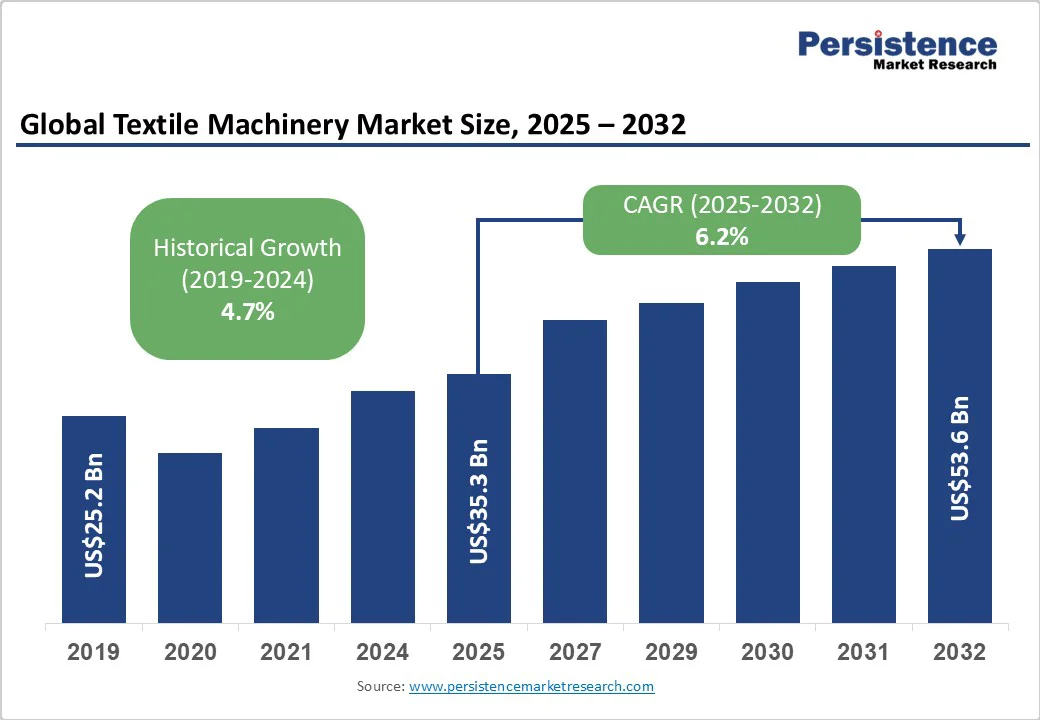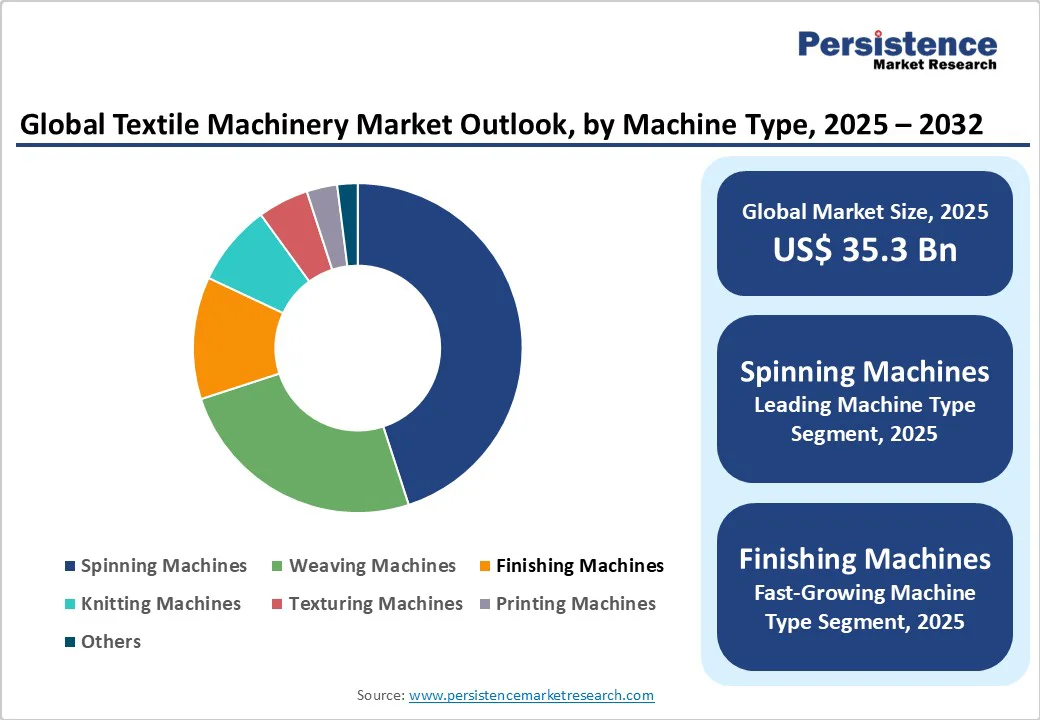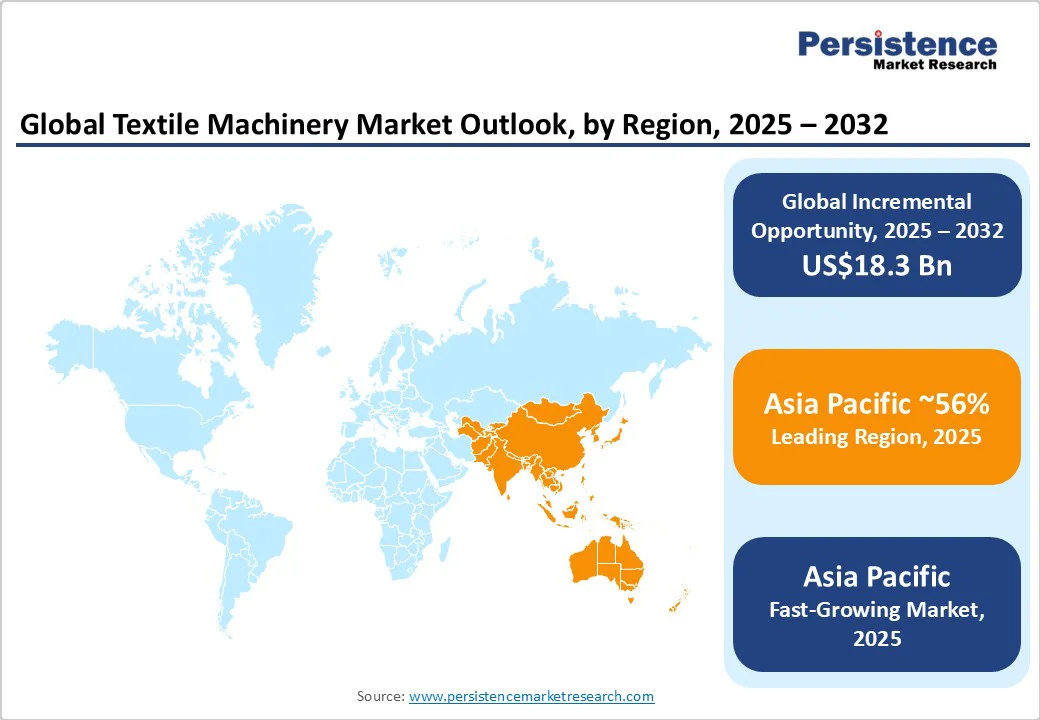ID: PMRREP35746| 181 Pages | 16 Oct 2025 | Format: PDF, Excel, PPT* | Industrial Automation

The global textile machinery market size is likely to be valued at US$35.3 Billion in 2025, and is estimated to reach US$53.6 Billion by 2032, growing at a CAGR of 6.2% during the forecast period 2025 - 2032, driven by advancements in automation and the burgeoning demand for technical textiles.
Industrial automation, rising demand for sustainable fabrics, and expanding textile production in Asia Pacific are also factors that are spurring market growth.
| Key Insights | Details |
|---|---|
| Textile Machinery Market Size (2025E) | US$35.3 Bn |
| Market Value Forecast (2032F) | US$53.6 Bn |
| Projected Growth (CAGR 2025 to 2032) | 6.2% |
| Historical Market Growth (CAGR 2019 to 2024) | 4.7% |

The textile machinery industry is actively adopting Industry 4.0 principles, integrating AI, IoT, and robotics into manufacturing processes. Industrial automation is reducing labor dependency, cutting operational costs considerably, and enhancing production speed, which strengthens competitiveness amid rising wage pressures in emerging manufacturing hubs.
Regulatory bodies such as the International Labour Organization (ILO) promote such technological upgrades to improve workplace safety, indirectly driving adoption. This trend is incentivizing machinery vendors to innovate, with smart machinery increasingly demanded across spinning, weaving, and finishing segments.
Businesses embracing these advancements improve yield consistency and energy efficiency, positioning themselves to capture higher market shares in global textile manufacturing.
Technical textiles are projected to see a robust growth trajectory. Tightening automotive safety standards, expanding healthcare infrastructure, and heightened environmental regulations are stimulating the demand for specialized textile products requiring advanced machinery.
A study highlights that technical textiles constitute over 25% of the total textile output in developed economies, with emerging markets rapidly increasing their share, fueled by infrastructure development and growing automotive manufacturing.
This escalating demand necessitates upgraded machinery capable of producing high-performance fabrics with enhanced durability and specific functional properties. Consequently, textile machinery manufacturers are allocating R&D resources to develop equipment tailored to these applications, opening avenues for targeted investment and product portfolio diversification.
The initial investment and ongoing maintenance for advanced textile machinery remain prohibitive, especially for small and medium enterprises (SMEs). Industry data indicates that state-of-the-art automated systems cost 30%-40% more than traditional equipment, which constrains adoption in price-sensitive regions.
Skilled labor scarcity elevates maintenance expenses, with unplanned downtime resulting in revenue losses up to 15% in affected facilities. Regulatory compliance for safety and emissions further escalates operational costs. These capital and operational cost barriers limit penetration in developing markets where financial constraints prevail, potentially slowing global market momentum unless mitigated by financial support or leasing models.
The textile machinery supply chain is experiencing disruptions from geopolitical tensions and pandemic-era logistics bottlenecks, resulting in component shortages and prolonged lead times. Raw material price fluctuations, notably of steel and electronic parts, can potentially increase manufacturing costs by up to 12%, impacting machinery prices.
These pressures elevate risks for manufacturers and buyers, complicating procurement planning and capital budgeting. Elongated supply chain uncertainties can delay equipment installation and upgrade cycles, constraining market responsiveness to demand surges and technological shifts.
Rapid textile industrialization in Asia Pacific and parts of Africa presents substantial growth potential. Countries including India, Vietnam, and Bangladesh are experiencing 7%-9% expansion rates in textile production capacity, driven by demographic advantages and export-oriented policies, according to UNIDO reports.
Government incentives aimed at modernizing manufacturing infrastructure and promoting sustainability, such as subsidies and tax breaks, are accelerating machinery investments. This emergence fosters demand for mid-to-high-end machinery adapted to local manufacturing practices, offering machinery providers avenues for customized solutions and significant market penetration.
The growing emphasis on sustainability and regulatory pressures to reduce carbon footprints are steering investments toward energy-efficient and digitally connected machinery. Research from the International Textile Manufacturers Federation shows that sustainable textile machinery adoption could reduce industrial water consumption by 30% and energy usage by 25%, directly benefiting production costs and environmental compliance.
Smart manufacturing systems equipped with real-time monitoring enable predictive maintenance and resource optimization, appealing to manufacturers seeking lifecycle cost reduction and compliance risk mitigation. This convergence represents a strategic opportunity to integrate sustainability credentials with digital transformation, expanding market differentiation and customer value propositions.
Spinning machines are projected to maintain dominance, estimated to hold approximately 44% of the textile machinery market share in 2025, and continue as the backbone of yarn production globally. This leadership is underpinned by the rising consumption of cotton and synthetic fibers in burgeoning textile hubs such as China, India, and Bangladesh.
Technological improvements such as energy-efficient compact spinning and automated doffing systems contribute to productivity gains up to 25%, appealing to manufacturers balancing cost and efficiency. Underlying this dominance are fast-fashion demands and integrated supply chains, requiring scalable and versatile spinning technologies.
Finishing machines represent the fastest-growing machinery segment, driven by increasing demand for fabrics with enhanced durability, appearance, and functional properties such as wrinkle resistance and stain repellency.
Processes including heat-setting, calendering, and sanforizing receive rising investments to meet premium textile product standards. This dynamic reflects manufacturers’ strategic shift toward value addition and differentiation from commodity markets, reinforcing finishing machines’ pivotal role in future industry transformations.
Semi-automatic textile machinery accounts for the largest estimated market share of approximately 43% in 2025, as these machines are largely favored in mid-tier manufacturing setups globally due to a balanced equation of operational efficiency and capital expenditure. This segment thrives amid evolving production models where partial automation addresses labor shortages without incurring prohibitive costs.
Fully automatic smart machinery is accelerating as the fastest-growing automation category. Driven by the industrial digitization wave, these machines incorporate AI, IoT sensors, and robotics to enhance process control, predictive maintenance, and energy efficiency.
Leading textile mills, particularly in developed and high-growth Asian markets, are early adopters aiming to secure competitive advantages via superior quality, consistency, and supply chain responsiveness.
The garments and apparel segment is anticipated to constitute about 62.7% of the market share in 2025 due to booming consumer demand for diverse fashion and casual wear across emerging and developed markets.
Growth factors include rising disposable incomes, changing style preferences, and the exponential rise of e-commerce and fast-fashion business models demanding high flexibility and throughput. Textile machinery aligned to this application emphasizes rapid changeover, energy efficiency, and quality control, enabling manufacturers to meet fluctuating consumer trends efficiently.
Technical textiles are the fastest-growing application segment over the forecast period 2025 - 2032. This surge stems from expanding usage in automotive safety components, medical textiles, filtration media, and protective clothing, all of which demand high-performance fabrics manufactured via advanced, specialized machinery.
This trajectory is further supported by increasing regulatory requirements across automotive and healthcare sectors globally, incentivizing the adoption of textile machinery capable of producing complex technical textiles with consistent precision.

Asia Pacific is set to dominate the global textile machinery landscape with an estimated 56% share in 2025, attributable to the manufacturing scale and textile exports primarily from China, India, Japan, Vietnam, and Bangladesh. The regional market is forecast to expand at the highest CAGR over 2025 - 2032. Prominent growth drivers include large-scale industrialization, abundant labor supply, export-focused policies, and competitive production costs.
Government initiatives promoting modernization and sustainability, such as subsidies for energy-efficient machinery and digital technologies, are significantly fueling capital investments. The competitive advantages for textile companies in Asia Pacific include rapidly growing textile and garment manufacturing capacities, extensive supplier networks, and dynamic market adaptability.
Regulatory compliance is increasingly enforced through national standards aligning with global norms, accelerating machinery upgrade demand. The competitive landscape is highly innovative and price-competitive, emphasizing rapid adoption of automation and smart technologies to maintain global supply chain relevance and market leadership.
Market leaders are deploying innovation-centric strategies, emphasizing advanced automation and eco-friendly machinery to differentiate offerings. Cost leadership is pursued through efficient production and service models targeting developing markets.
Market expansion via acquisitions, joint ventures, and regional partnerships enables access to emerging textile hubs. Business models incorporating subscription-based maintenance and digital services are emerging, reflecting a shift toward comprehensive customer lifecycle solutions.
North America is expected to account for approximately 18% of the market share in 2025, with the U.S. as the primary driver. Regional market growth is underpinned by the strong manufacturing sector of the U.S., which places great emphasis on technical textiles and the adoption of Industry 4.0 technologies integrating automation and smart controls.
Robust regulatory frameworks focusing on worker safety, environmental impact, and emission norms necessitate constant machinery upgrades, incentivizing investments in cutting-edge equipment.
The presence of prominent machinery manufacturers and a vibrant R&D ecosystem further propels innovation, supporting advancements in energy efficiency and precision processes. Investment trends reflect a shift toward retrofit solutions for aging infrastructure alongside new plant installations. Tariff regimes and nearshoring strategies also influence supply chains, encouraging localized production and accelerating machinery procurement cycles.
Europe is projected to hold about 22% of the textile machinery market share in 2025, anchored by mature textile manufacturing hubs within Germany, the U.K., France, Spain, and neighboring countries. The Europe market is expected to grow at a high CAGR through 2032, supported by harmonized regulatory policies under the European Union (EU) aimed at sustainability and energy efficiency.
Environmental directives incentivize manufacturers to adopt low-emission and water-saving technologies embedded in modern textile machinery, driving upgrade cycles.
The competitive environment features established machine makers focusing on high-precision, customized solutions meeting strict compliance standards. Investments emphasize digitalization and smart manufacturing integration, with public and private sector funding accelerating technology adoption. The regional market also benefits from a strong export orientation, where innovation-driven machinery supports penetration into global technical textile markets.

The global textile machinery market structure is moderately consolidated, with the top 10 players accounting for an estimated 63.5% of the total market share. Leading companies include Toyota Industries Corporation, Picanol NV, Trützschler Group, and Savio Macchine Tessili SPA, among others, each holding significant niche influence.
Market concentration is shaped by technology specialization, global distribution networks, and innovation capabilities. Competitive positioning is accentuated by R&D investments and geographic presence, with regional manufacturers focusing on cost-effective solutions while multinationals emphasize automated and smart machinery.
The textile machinery market is projected to reach US$35.3 Billion in 2025.
Increased industrial automation, shifting consumer preferences toward sustainable fabrics, and thriving textile manufacturing activities in Asia Pacific are driving the market.
The market is poised to witness a CAGR of 6.2% from 2025 to 2032.
Advancements in industrial automation, burgeoning demand for technical textiles, regulatory emphasis on eco-friendly production technologies, and government incentives promoting upgrades in textile manufacturing are key market opportunities.
Toyota Industries Corporation, Picanol NV, and Trützschler Group are some of the key players in the textile machinery market.
| Report Attribute | Details |
|---|---|
| Historical Data/Actuals | 2019 - 2024 |
| Forecast Period | 2025 - 2032 |
| Market Analysis | Value: US$ Bn |
| Geographical Coverage |
|
| Segmental Coverage |
|
| Competitive Analysis |
|
| Report Highlights |
|
By Machine Type
By Automation Type
By Application
By Region
Delivery Timelines
For more information on this report and its delivery timelines please get in touch with our sales team.
About Author